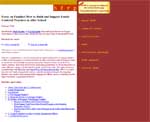
Harvard Family Research Project, in partnership with BOSTnet and
United Way of Massachusetts Bay, announces the release of a new
comprehensive, easy-to-read guide to understanding how to engage
families in after school programs.
“Focus on Families! How to Build and Support Family-Centered Practices in After School” is a critical resource for after school providers looking to create or expand an existing family engagement program. Program leaders, local decision makers, funders, and others interested in promoting good family involvement practice will also find the guide vital to their work. The guide provides a research base for why family engagement matters, concrete program strategies for engaging families, case studies of promising family engagement efforts, and an evaluation tool for improving family engagement practices.
You can read the guide online or print it as a PDF at:
http://www.gse.harvard.edu/hfrp/projects/afterschool/resources/families
Hard copies are available upon request. The guide is also available from BOSTnet (http://www.bostnet.org) and United Way of Massachusetts Bay (http://www.uwmb.org).
“Focus on Families! How to Build and Support Family-Centered Practices in After School” represents a key component of HFRP’s ongoing efforts to understand and promote best practice in linking OST programs to
families. It is also an important piece of HFRP’s new “complementary learning” approach to supporting children’s learning and development. Complementary learning is based on the principle that for young people to be successful from birth through adolescence they need access to an array of quality learning
contexts that extend beyond the school and are linked to one another.
These learning contexts include early childhood programs, out-of-school time programs, community institutions such as health and social services agencies, families, and, of course, schools. Visit the Complementary Learning section of the website to learn more about this new approach.
